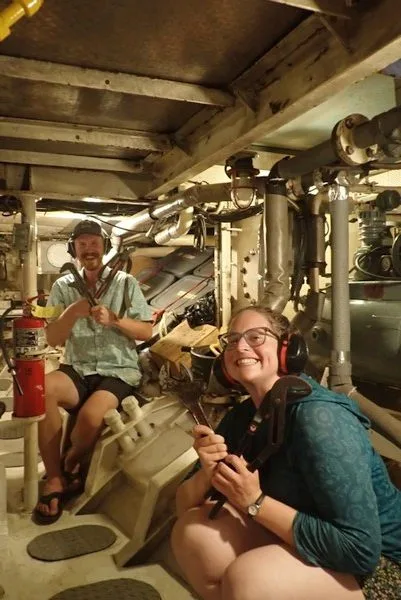News
Don’t Forget Your Ear Muffs.

Josh and Anne, Chief Engineer and Assistant Engineer
Ship’s Log
Noon Numbers
1456 gal Fuel oil (diesel),
4247 gal Fresh Water,
Main Engine Hours: 33790
Main Generator Hours: 23110
Deck Generator Hours: 12761
Water used Totalizer: 1483123
Water Made Totalizer: 0906105
FWD Sewage Tank Level: 1.0 ft
Aft Sewage Tank Level: 0.25ft.
Ship Speed (knots):7.2kts
Engines online: Main Engine, 1300RPM, Power from the Deck Generator Description of location: Between St. Thomas and St. John, USVI.
The engineer’s job boils down to keeping the lights on, the water flowing, and propulsion available when the wind is no longer in our favor. If we are doing our job well, the systems onboard should flow seamlessly and everyone else can do their jobs, too. We keep up on preventative maintenance and respond to issues big and small as they arise. Finally, when things are going well, we stay sane by dabbling outside the bounds of engineering as well.
When we cannot sail, propulsion comes from our 500 HP Cummins main engine.
Its power is transmitted through our twin disk clutch to a controllable pitch propeller. This propeller allows us to feather the flukes for less resistance while sailing or to control our prop walk when backing out of a tight mooring. Our power is supplied by one of our two generators onboard.
Our main generator (40 KW) supplies ample power to run the science equipment during deployments as well as the commercial kitchen appliances in the galley. We also have our deck generator (20 KW) which can serve our power needs during non-peak usage. The deck generator could also serve as a standalone back up should our main generator fail or become unusable in an emergency. All of our water systems onboard including hoses, bilge pumps, sinks, and heads are operated by electric pumps.
On a good day, most of our efforts go towards the daily, weekly and monthly preventative maintenance schedules that have been developed for the Corwith Cramer. We much prefer attempting to prevent a problem rather than responding to one. Every day, we check the oil and coolant levels and monitor the fuel filters for all 6 of the engines we have onboard. We regularly exercise our emergency systems, such as dewatering and fire pumps, to check for proper operation. We also keep a close eye on the refrigeration system that keeps our fridges and freezers cold. When we are underway we make fresh water by running our reverse osmosis water makers.
As hard as we try, preventative maintenance is never enough and we usually end up responding to a few unexpected problems every day too. Rust has seized this, someone’s clogged that, and some fitting is leaking in a tough to reach spot.
In the spirit of education, we also like to broaden our experience to other aspects of the ship.
When we have an opportunity, we love to jump in on sail handling, drive one of the small boats, help with dishes in the galley, or appreciate the sunrises and sunsets. Our latest project outside of engineering has been practicing celestial navigation by taking noon sextant sightings. With the angle from a sighting, an accurate time piece, and the almanac, we can calculate our latitude. It’s fun comparing our calculated lat/long to the GPS we have onboard.
Some numbers we use every day:
Let’s say that the sight glass on the #2 Freshwater tank (conventional numbering = port fwd tank) read 2400 L of water yesterday and 1700 L today.
How many gallons did we use? How many do we have left in that tank?
2400L-1700L = 700L
700L (1Gal/3.785L) = _______184.5 Gal_____ 1700L( 1 Gal/3.785L) =_______449 Gal_____ Did you catch the unit conversion? There’s always a unit conversion.
If the watermaker gauge read 0906174 gallons at noon yesterday and 906694 gallons at 0800 today, how much water did we make? How many gallons per hours? Are we keeping up with consumption? What are they doing with it all?
Why are the heads flushed with fresh water????
A ranking of our favorite engineering tricks:
- Turn it off and on again
- Wait and check it in ten minutes
- Flush the head again
- Wrench on screwdriver
- Pipe on wrench
- Wrench on wrench
- Turn it off and on again again.
Our favorite tools:
- Flashlight
- Monkey wrench
- Channel locks
To sum up our role:
Head not flushing? Call us.
Wire not deploying? Call us.
Outboard not working? Call us.
Favorite wrench missing? Not us. We always put our tools away.
Want more power to make the ship go faster/ ride smoother? Set more sails.
The main engine is HOT and LOUD and we like to sail too!
Josh and Anne, Chief Engineer and Assistant Engineer